IASbaba's Daily Current Affairs Analysis
Archives
(PRELIMS + MAINS FOCUS)
India adds two more Ramsar sites
Part of: GS Prelims and GS-III – Environment
In news
- India has recently added two more Ramsar sites.
- One is Lonar lake in Maharashtra which is the only crater lake of India.
- The other is Sur Sarovar, also known as Keetham lake in Agra, Uttar Pradesh.
Important value additions
The Ramsar Convention
- It was signed on 2nd February, 1971.
- It is one of the oldest inter-governmental accords signed by member countries.
- Objective: To preserve the ecological character of their wetlands of international importance.
- It is named after Ramsar, the Iranian city where the treaty was signed.
- Places chosen for conservation under it are given the tag ‘Ramsar site’.
- The aim of the Ramsar list: To develop and maintain an international network of wetlands which are important for the conservation of global biological diversity and for sustaining human life through the maintenance of their ecosystem components, processes and benefits.
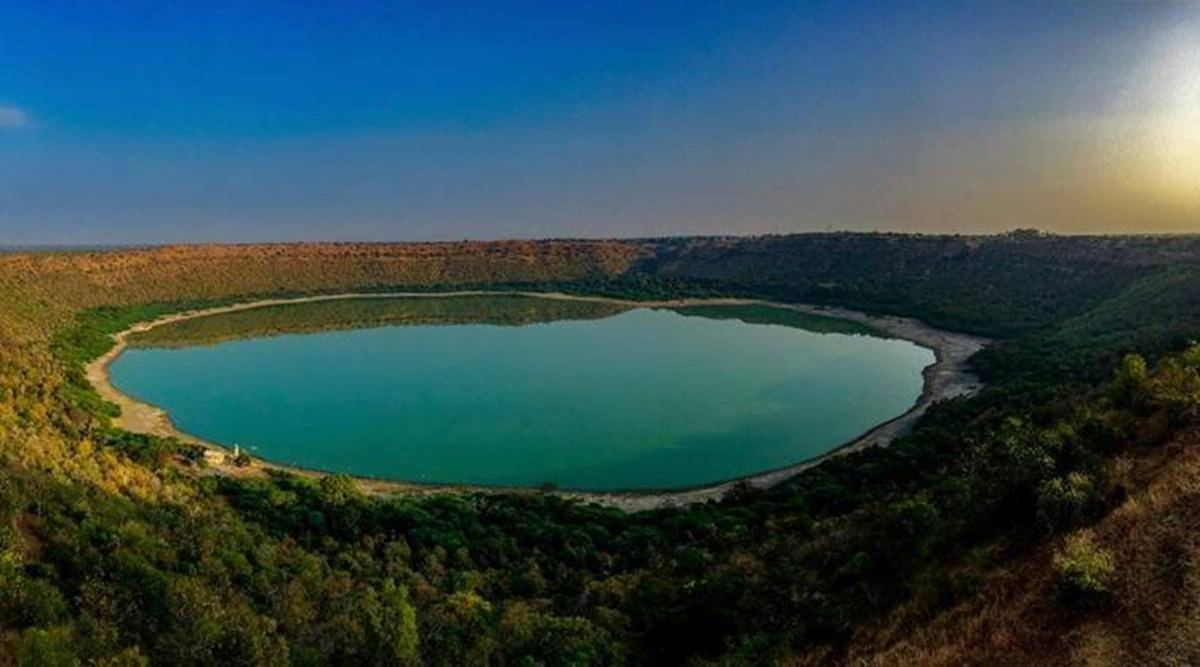
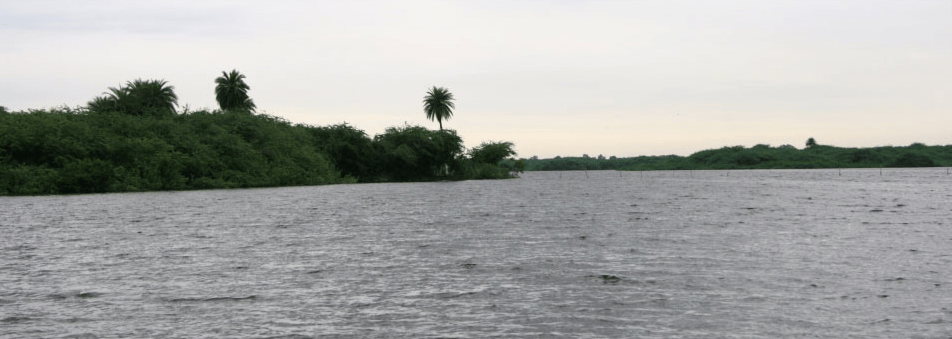
Do you know?
- Recently, Kabartal in Bihar’s Begusarai district was recognised as a wetland of international importance.
- It is the first such wetland in the state, under the Ramsar Convention, according to the Union Environment Ministry.
- The Asan Conservation Reserve in Dehradun, the first wetland from Uttarakhand to be recognised by Ramsar convention, was added to the list in October this year.
Place in news: Peru
Part of: GS Prelims and GS-I – Geography
In news
- Peru’s fifth president in five years, Manuel Merino, was forced out of power, just five days after taking office, as massive protests swept Peru over alleged bribery – charges on the Presidet.
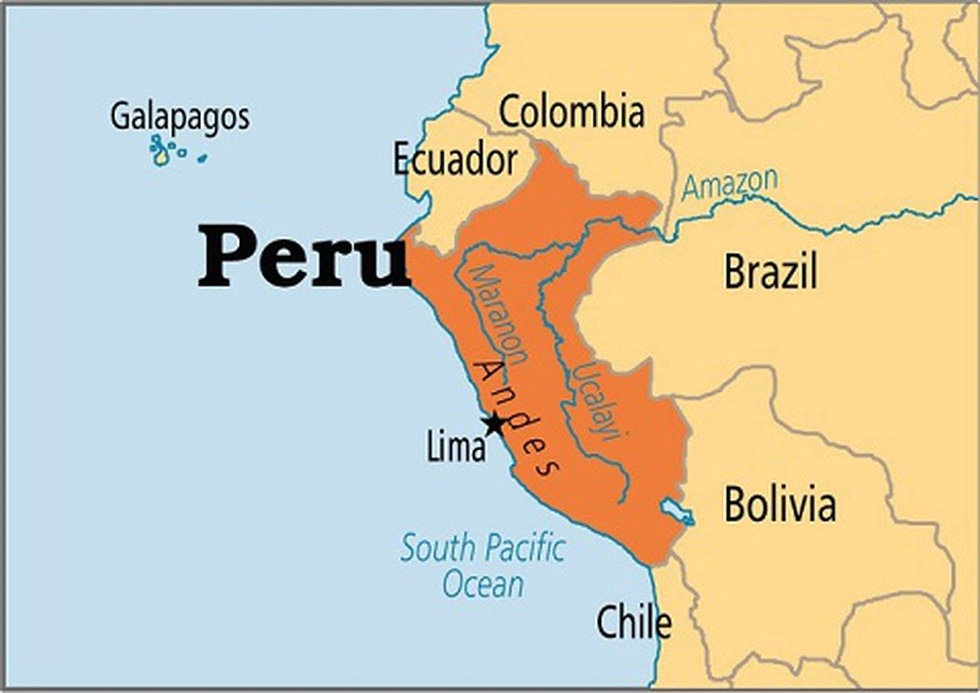
Important value additions
Peru
- It is a country in western South America.
- It is bordered in the north by Ecuador and Colombia, in the east by Brazil, in the southeast by Bolivia, in the south by Chile, and in the south and west by the Pacific Ocean.
- Peru is a megadiverse country with habitats ranging from the peaks of the Andes mountains vertically extending from the north to the southeast of the country to the tropical Amazon Basin rainforest in the east with the Amazon river.
- The country forms part of The Pacific Pumas, a political and economic grouping of countries along Latin America’s Pacific coast that share common trends of positive growth, stable macroeconomic foundations, improved governance and an openness to global integration.
- Its Capital is Lima.
Place in news: Puerto Rico
Part of: GS Prelims and GS-I – Geography & GS-II – International Relations
In news
- For the third time in ten years, the United States territory of Puerto Rico has voted in favour of statehood, and thus be treated at par with the current 50 states of the country.
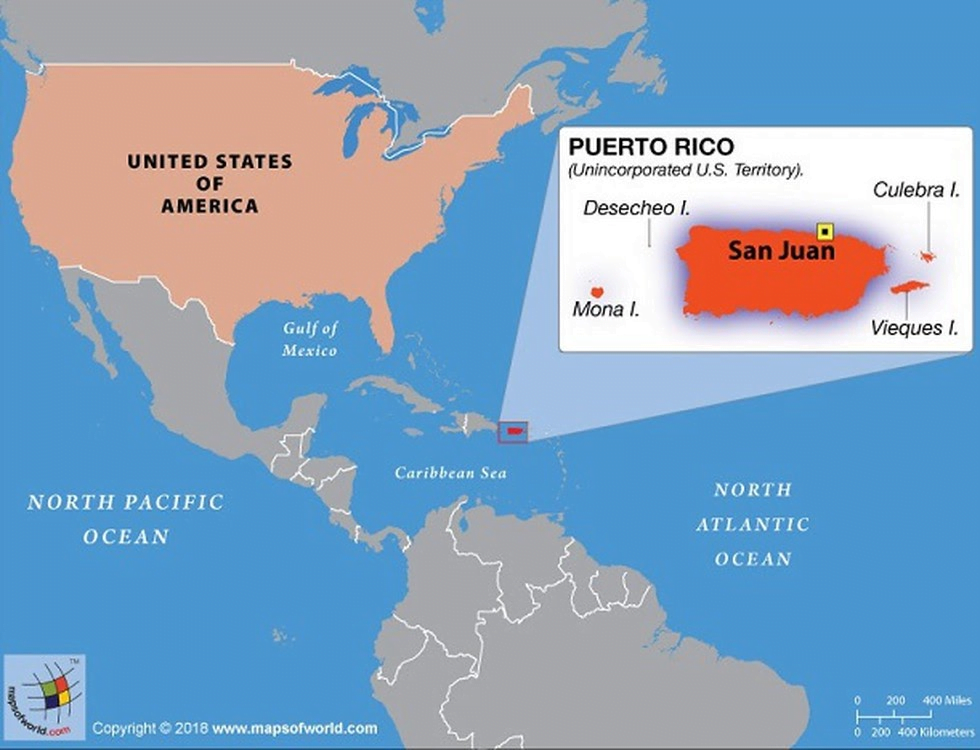
Important value additions
Puerto Rico
- It is an unincorporated territory of the United States.
- Puerto Ricans have been citizens of the United States since 1917, and can move freely between the island and the mainland.
- As it is not a state, Puerto Rico does not have a vote in the U.S. Congress, which governs the unincorporated territory with jurisdiction under the Puerto Rico Federal Relations Act of 1950.
- It is located in the northeast Caribbean Sea.
- It includes the eponymous main island and several smaller islands, such as Mona, Culebra, and Vieques.
- The capital and most populous city is San Juan.
Do you know?
- Originally populated by the indigenous Taíno people, Puerto Rico was colonized by Spain following the arrival of Christopher Columbus in 1493.
- In 1898, following the Spanish–American War, the United States acquired Puerto Rico, which remains an unincorporated territorial possession, making it the world’s oldest colony.
China’s Railway work Near Arunachal Border
Part of: GS Prelims and GS-II – International Relations
In news
- China has begun work on a strategically significant railway line.
- It will link Sichuan province with Nyingchi in Tibet, which lies close to Arunachal Pradesh border.
Key takeaways
- This will be the second such route linking Tibet Autonomous Region (TAR) with mainland China.
- Earlier Qinghai-Tibet railway line connected Lhasa to the hinterland.
- The railway line will largely improve the efficiency and convenience of China’s military personnel and material transportation and logistical supplies in the border area. Thus, China might be at an advantageous position.
- The fragile ecological environment along the project line, may have ecological concerns for India.
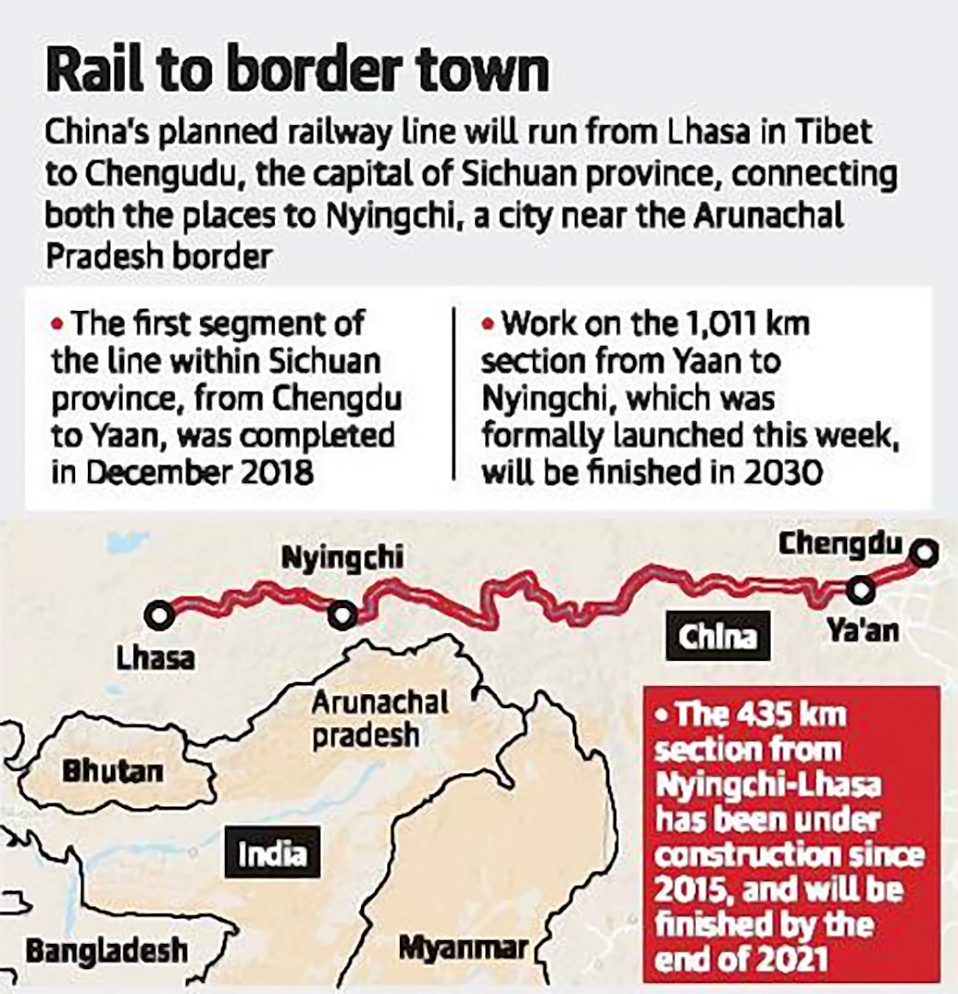
Quick Reaction Surface-to-Air Missile System successfully test-fired
Part of: GS Prelims and GS-III – Defence & Security
In news
- Recently, Defence Research and Development Organisation (DRDO) successfully test-fired Quick Reaction Surface-to-Air Missile system (QRSAM).
Key takeaways
- QRSAM is a canister-based system.
- It means that it is stored and operated from specially designed compartments.
- In the canister, the inside environment is controlled, thus along with making its transport and storage easier, the shelf life of weapons also improves significantly.
- The system is capable of detecting and tracking targets on the move and engaging targets with short halts.
- It is a short range surface-to-air missile (SAM) system.
- It is primarily designed and developed by DRDO to provide a protective shield to moving armoured columns of the Army from enemy aerial attacks.
- The entire weapon system has been configured on a mobile and is capable of providing air defence on the move.
- It has been designed for induction into the Army.
Do you know?
- It has a range of 25 to 30 km.
- It also consists of two radars – Active Array Battery Surveillance Radar and Active Array Battery Multifunction Radar – with one launcher.
- Both radars have 360-degree coverage with “search on move” and “track on move” capabilities.
- The system uses a single stage solid propelled missile.
Miscellaneous
Statue Of Peace
-
The Indian Prime Minister unveiled ‘Statue of Peace’ to mark the 151st Birth Anniversary celebrations of Jainacharya Shree Vijay Vallabh Surishwer Ji Maharaj.
- He was a Jain Acharya.
- The statue is made from Ashtadhatu i.e. 8 metals, with Copper being the major constituent.
- It is installed at Vijay Vallabh Sadhana Kendra, Jetpura, in Pali, Rajasthan.
Shree Vijay Vallabh Surishwer Ji Maharaj (1870-1954)
- He led an austere life as a Jain Saint working selflessly and dedicatedly to spread the message of Lord Mahavira.
- He also worked relentlessly for the welfare of masses, the spread of education, eradication of social evils, wrote inspiring literature and gave active support to the freedom movement and the cause of Swadeshi.
Jolly Grant Airport
- Environmental activists and local residents in Uttarakhand are opposing the cutting of trees for a project to expand Dehradun’s Jolly Grant airport.
- Dehradun Airport is also known as Jolly Grant Airport.
- It is also known as the Air Gateway of Garhwal and plays an important role in the tourism of Uttarakhand.
- The Uttarakhand Civil Aviation Development Authority has proposed the expansion of Jolly Grant airport in Dehradun with the aim of upgrading it to meet international standards.
- It is proposed to take over 87 hectares of forest land in Doiwala village in Dehradun district, and another 17.41 hectares of non-forest land for the project.
(MAINS FOCUS)
INTERNATIONAL/ ECONOMY
Topic: General Studies 2, 3:
- Bilateral, regional and global groupings and agreements involving India and/or affecting India’s interests
- Indian Economy and issues relating to planning, mobilization, of resources, growth, development and employment.
India and RCEP
Context: 15 countries came together and signed the Regional Comprehensive Economic Partnership (RCEP) on the sidelines of an online ASEAN summit hosted by Vietnam on 15th Nov 2020.
Even as India opted to stay out after walking out of discussions last year, the new trading bloc has made it clear that the door will remain open for India to return to the negotiating table.
What is RCEP?
- RCEP was originally being negotiated between 16 countries — ASEAN members and countries with which they have free trade agreements (FTAs), namely Australia, China, Korea, Japan, New Zealand and India.
- Objective: The purpose of the deal is to create an “integrated market” spanning all 16 countries. It would make it easier for products and services of each of these countries to be available across this region.
- Mega Trade deal: It was described as the “largest” regional trading agreement as the countries involved account for almost half of the world’s population, contribute over a quarter of world exports, and make up around 30% of the global GDP.
- Negotiations to chart out this deal had been on since 2013, and India was expected to be a signatory until its decision in November 2019 to stay out of the deal.
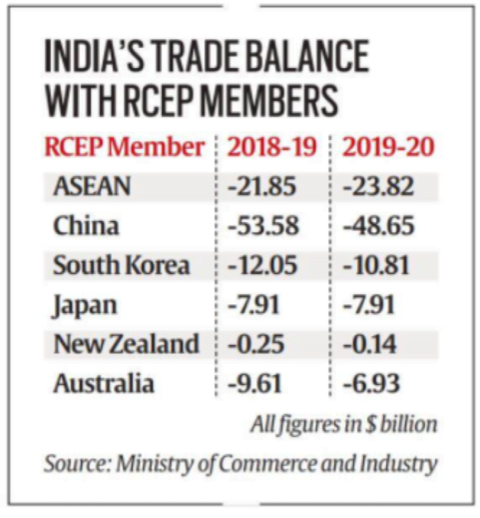
Why did India walk out?
- Unfavourable Balance of Trade: India has trade deficits with 11 of the 15 RCEP countries, and some experts feel that India has been unable to leverage its existing bilateral free trade agreements with several RCEP members to increase exports.
- Fear of Dumping of Chinese Goods: India has already signed FTAs with all the countries of RCEP except China. This is the major concern for India, as after signing RCEP cheaper products from China would have flooded the Indian market.
- Non-acceptance of Auto-trigger Mechanism: In order to deal with the imminent rise in imports, India had been seeking an auto-trigger mechanism that would have allowed India to raise tariffs on products in instances where imports cross a certain threshold. However, other countries in RCEP were against this proposal.
- Lack of Consensus on Rules of Origin: Rules of origin are the criteria used to determine the national source of a product. India was concerned about a “possible circumvention” of rules of origin. The deal did not have sufficient safeguards to prevent routing of the products.
- Protecting domestic industries: Throughout the negotiations, the dairy industry demanded protection as the industry was expected to face stiff competition from Australia and New Zealand when the deal was signed. Similarly, steel and textiles sectors have also demanded protection.
- MFN Status: India wanted RCEP to exclude most-favoured nation (MFN) obligations from the investment chapter, as it did not want to hand out, especially to countries with which it has border disputes, the benefits it was giving to its strategic allies
- Issue of Market Access: RCEP also lacked clear assurance over market access issues in countries such as China and non-tariff barriers on Indian companies.
- Lack of Commitment to resolve above issues: India had been “consistently” raising “fundamental issues” and concerns throughout the negotiations and was prompted to take this stand as they had not been resolved by the deadline to commit to signing the deal.
- No deal better than bad agreement: India’s stance was based on a “clear-eyed calculation” of the gains and costs of entering a new arrangement, and that no pact was better than a “bad agreement”.
How far is China’s presence a factor for India’s decision?
- Apart from economic reasons (fear of dumping), escalating tensions with China are a major reason for India’s hardened position on the deal.
- China’s participation in the deal had already been proving difficult for India due to various economic threats, the clash at Galwan Valley has soured relations between the two countries.
- The various measures India has taken to reduce its exposure to China would have sat uncomfortably with its commitments under RCEP
Why is RCEP important for China?
- China is trying to overcome Covid-19 disruptions and resurrect the supply chain mechanism and possibly put pressure on US President-elect Joe Biden.
- The Indo-Pacific so far ran on twin tracks of economy and security with economy on a weak wicket.
- China is trying to strengthen the economic base while the US is focussed on the security aspects.
- For India, RCEP hardly makes a difference as it has FTAs with ASEAN, and CEPAs (Comprehensive Economic Partnership Agreements) with Japan and South Korea already.
What can the decision cost India?
- Indirectly benefits China: RCEP is a China-backed trade deal, signing it without India will further strengthen China’s economic power. It will affect India’s neighbourhood as China already tries to influence the region through its deep pockets.
- Impact on India’s Act East Policy: There are concerns that India’s decision would impact its bilateral trade ties with RCEP member nations, as they may be more inclined to focus on bolstering economic ties within the bloc.
- Losing out on Large Market: The move could potentially leave India with less scope to tap the large market that RCEP presents —the size of the deal is mammoth, as the countries involved account for over 2 billion of the world’s population.
- Impact on other initiatives: There are also worries that India’s decision could impact the Australia-India-Japan network in the Indo-Pacific. It could potentially put a spanner in the works on informal talks to promote a Supply Chain Resilience Initiative among the three.
What are India’s options now?
- Can Join in future: Japan worked hard to keep the RCEP agreement “open for accession by India” and also said that India may participate in RCEP meetings as an “observer”.
- Observer in RCEP meetings: RCEP signatory states said they plan to commence negotiations with India once it submits a request of its intention to join the pact “in writing”, and it may participate in meetings as an observer prior to its accession.
- RCEP not connected to its vision on Indo-Pacific: Indian government has made it clear that India was not about to step back from its Act East policy, nor was the decision on RCEP connected to its approach to the Indo-Pacific
- Exploring other alternatives: There is also a growing view that it would serve India’s interest to invest strongly in negotiating bilateral agreements with the US and the EU, both currently a work in progress.
Conclusion
- When India chose to stay out of the Belt and Road Initiative in 2017, there was much commentary that India might be isolating itself. Three years later, India’s position has been recognised by like-minded democracies, and many have said that India’s decision was prescient.
- Likewise, India’s decision on RCEP which was based on principles will be recognised by other like-minded countries.
- Instead of sitting out and building tariff walls across sectors, it must prod and incentivise the industry to be competitive, and get inside the RCEP tent at the earliest opportune moment.
Connecting the dots:
SOCIETY/ GOVERNANCE/ ECONOMY
Topic: General Studies 1, 2 ,3:
- Role of women in society and their associated issues.
- Government policies and interventions for development in various sectors and issues arising out of their design and implementation.
- Inclusive growth and issues arising from it.
Women Employment
Context: The year 2020 marks the anniversary of two major events concerning the status of women.
- First, it is nearly fifty years since the Committee on the Status of Women in India (CSWI) submitted the report ‘Towards Equality’ to the United Nations (UN), which focused on women-sensitive policymaking in India, providing a fresh perspective on gender equality.
- Second, it is the 25th anniversary of the Beijing Platform for Action, a benchmark for analysing the condition of women and State-led empowerment.
Issues of Women’s Economic Participation
- Economic Growth not translating into employment: India’s female employment trends do not resonate with its high economic growth, low fertility, and rise in female schooling.
- Declining Female Labour Force Participation rate: Periodic Labour Force Survey (PLFS), 2018-19 shows that women faced a decline in labour participation rates (from 2011 to 2019) in rural areas from 35.8% to 26.4%, and stagnation in urban areas at around 20.4%.
- Low Global Ranking: Furthermore, the World Economic Forum’s Global Gender Gap Report ranks India at 149 among 153 countries in terms of women’s economic participation and opportunity.
- Wage Gap: The gender wage gap is the highest in Asia, with women 34% below men (for equal qualification and work), according to a 2019 Oxfam report. This stifles women’s labour force participation, despite the guarantees of India’s Equal Remuneration Act, 1976.
- Feminisation of Agriculture: Agriculture that is an almost completely informal sector employs nearly 60% of women, who form the bulk of landless labourers, with no credit access, subsidies, little equipment, and lack of social security measures.
- Abysmal Land ownership: Only about 13% of women tillers owned their land in 2019.
- Low participation in Manufacturing Sector: Manufacturing employs (almost completely informally) only around 14% of the female labour force.
- Care work dominates Women’s participation in Service Sector: According to the National Sample Survey (NSS) 2005, over 60% of the 4.75 million domestic workers are women.
- Unequal gender division of household work: Women spend (an unpaid) three times (as per NSS) or even six times (as per OECD) more time than men in household work.
- Overburdened Healthcare work: According to WHO, 70% of the world’s healthcare and social workers are women. In India, women are indispensable as frontline ASHA workers, but they are underpaid and overworked.
- Disproportionate impact of Pandemic: In India, the Centre for Monitoring Indian Economy (CMIE) showed that 39% of women lost their jobs in April and May compared to 29% of men, in the context of the ongoing pandemic.
Criticism of recently passed three labour codes w.r.t women issues
- The laws are expected to transform labour relations, but they only end up ‘easing business’.
- The codes acknowledge neither the gender wage gap nor non-payment of wages and bonuses, and ignore informal (mostly women) workers in terms of social security, insurance, provident fund, maternity benefits, or gratuity.
- Though ‘allowing’ women to work night shifts, there is little focus on accountability and responsibility
- Even protection from sexual harassment at workplace is missing.
- Maternity benefits remain unchanged from the 2017 amendment, with an insensitively formulated adoption leave policy that grants leave to women who adopt infants under the age of three months, ignoring that most children are much older at the time of adoption.
Conclusion
- The recent labour codes disregard women’s work conditions.
- Gender cannot be wished away, since every policy and code affects a giant proportion of India’s workforce — both paid and unpaid, acknowledged and unacknowledged.
(TEST YOUR KNOWLEDGE)
Model questions: (You can now post your answers in comment section)
Note:
- Correct answers of today’s questions will be provided in next day’s DNA section. Kindly refer to it and update your answers.
- Comments Up-voted by IASbaba are also the “correct answers”.
Q.1 Which of the following was recently added to Ramsar sites?
- Lonar lake
- Asan conservation reserve
- Kabar Tal
- Sur Sarovar
Select the correct code
- 1 and 3 only
- 4 only
- 1 and 4 only
- 1 and 2 only
Q.2 Andes mountain passes through which of the following countries of South America?
- Venezuela
- Peru
- Argentina
- Brazil
- Columbia
Select the correct code:
- 1, 2 and 3 only
- 3 and 4 only
- 1, 2 and 4 only
- 1, 2, 3 and 5 only
Q.3 Consider the following statements regarding Quick Reaction Surface to Air Missile System (QRSAM):
- QRSAM is a canister-based system.
- The system is capable of detecting and tracking targets on the move and engaging targets with short halts.
Which of the above is/are correct?
- 1 only
- 2 only
- Both 1 and 2
- Neither 1 nor 2
Q.4 Recently, statue of peace was unveiled in which of the following state of India by the Indian Prime Minister?
- Rajasthan
- Gujarat
- Uttar Pradesh
- Bihar
ANSWERS FOR 16th November 2020 TEST YOUR KNOWLEDGE (TYK)
| 1 | D |
| 2 | B |
Must Read
About lessons from Pulwana and Balakot attack:
About need for policy framework in step with technology:
About Herd Immunity debate:












